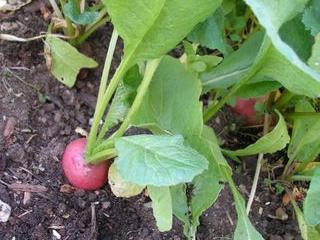
Our spring one-block feast: the appetizers are ready…NOW. But nothing else is.

It is so hard to get vegetables to ripen on schedule.
Our beets, favas, carrots, and radishes don’t care that we’ve planned a nice little ending for them in mid-May, when they’re supposed to all be ready simultaneously for our spring one-block feast. Instead, the favas–a giant ungainly green explosion of stalks—had to be harvested yesterday. The bean pods were practically the size of cucumbers. And the radishes were bulging up out of the ground. When that happens, chances are they’ll be stinging hot or fibrous. They almost look like they’re begging to be picked, don’t they?
Overgrown radishes.
So, we got up from our desks, went out into the garden, and picked.
That giant clump yielded 25 pounds of favas in about half an hour. Along with the radishes, they gave us this classic spring nibble, which we ate in the afternoon:
“Easter Egg II” radishes with shelled favas, soft butter, and sea salt.
We did what the French do: Spread each radish or bean with just a bit of butter, sprinkle with salt, and eat. A glass of sauvignon blanc, rosé, or pastis tastes wonderful with this. (By the way, the radishes were slightly spicy, but probably because of our recent heat wave–not because of their size. I had a big one last week and it was sweet as could be.)
When favas get large, like ours are, they need to be double-shelled. It’s kind of fun.HOW TO DOUBLE-SHELL A FAVA BEAN
1. Slit the pod, lined inside with a downy white fuzz that cradles each individual bean. Pick out the beans.
2. Plop the beans in well-salted boiling water for exactly two minutes. Drain them and pour them into a bowl of cold water. You’ll notice that a leathery skin has begun to separate from the inner bean.
3. When the beans are cool enough to handle, slit the skins with your fingernail or a paring knife and pop the inner beans out. What you see in the photo above are the naked beans. Fresh, green, and delicious.
WHEN YOU WANT A REALLY LARGE FAVA BEAN (AND WHEN YOU WANT A SMALL ONE)
For the kind of appetizer we just made, or for salads, monstrous favas are perfect because the beans are nice and fat and a couple make a good mouthful. Peeling tiny beans is maddening and plus it doesn’t yield much.
When fava pods are really small–no longer than the length of your little finger–they can be boiled in salted water for a couple of minutes, drained, and cooled. They taste similar to green beans, only richer. Don’t try this with bigger pods. You’ll be chewing on boiled leather.
A big fava with its beans, and a little pod for eating whole.






